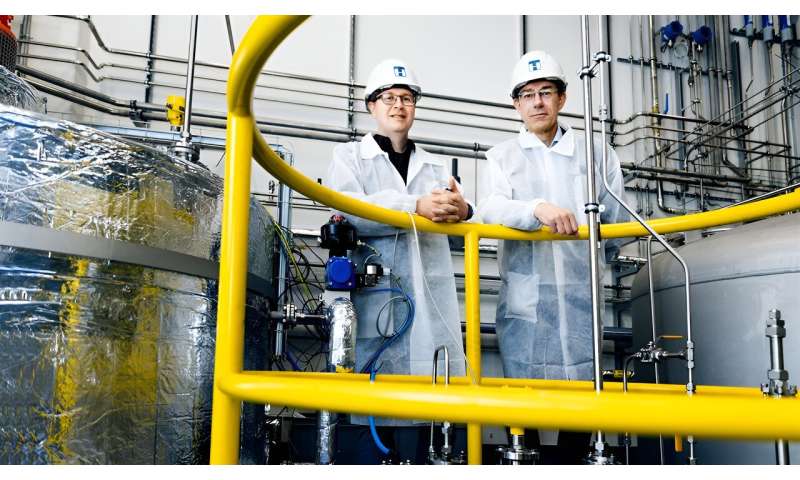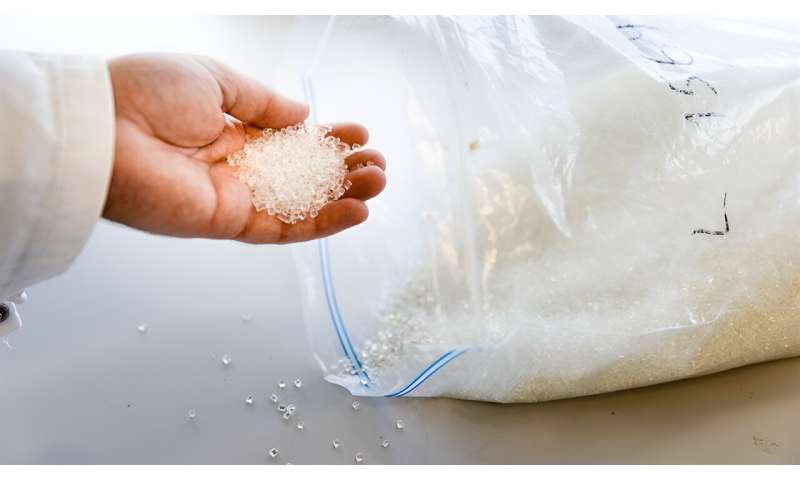Converting sugar into climate-friendly plastic

Sugar extracted from corn, sugar beet, and straw is the raw material for future plastic production. Danish company Topsoe is developing a new technology that will reduce the carbon footprint of plastic within a few years.
It's almost impossible to think plastic without also thinking fossil fuels. Because plastic is made from oil, from which we extract, among other things, carbon—an essential ingredient in plastic. Around 5%–6% of all crude oil pumped up from the ground currently goes towards making various plastic products.
But it doesn't have to be that way in the future. With new technology, biomass can be used as an alternative to fossil raw materials for plastic production. By replacing crude oil with biomass, we can achieve significant reductions in the carbon emissions associated with the production of plastic.
Together with DTU, Danish company Topsoe, which supplies technology for the green transition of chemical and fuel production etc., is developing a biomass-based method for producing one of the components used in the production of PET plastic. It is one of the most widely used plastics, used for example to make bottles for soft drinks and other forms of food packaging as well as polyester fibers for clothing and blankets.
"The aim is to convert sugar into ethylene glycol, which is one of the building blocks for making PET plastic," explains Esben Taarning, R&D Director, Sustainable Chemicals, at Topsoe.
Two-step process
The idea of converting sugar into ethylene glycol is not new. However, the technology is not terribly efficient and cannot compete with production based on crude oil.
"With this method, you lose a lot of the carbon along the way. The aim of our project is to retain as much as possible of the carbon contained in the sugar and transfer it to the ethylene glycol molecule. In this way, we can increase the yield derived from the sugar," explains Taarning.
The Topsoe-developed process involves two steps. First, an aqueous sugar solution is heated in a reactor. The heating from room temperature to 500°–600° results in sugar cracking—the decomposition of sugar molecules into smaller molecules. The main product resulting from sugar cracking is glycolaldehyde. During the second step of hydrogenation, hydrogen is added, leading to the formation of ethylene glycol, an important raw material in the production of plastic.
According to Taarning, the first part of the process—the breaking-down of the sugar molecules into smaller parts—is the groundbreaking achievement. And this is precisely the process step DTU Chemical Engineering has participated in. Professor Anker Degn Jensen has been involved from the very beginning in 2017.
"Initially, DTU helped develop the technology to a scalable level. The goal was to progress from a laboratory-scale reactor to a reactor measuring one meter in diameter and with a capacity of several hundred thousand tons of sugar a year," says Jensen.
Secret of the technology
The reactor used for the sugar cracking heats the sugar solution to 500°–600° in less than one second. And speed is paramount. Heating the sugar more slowly leads to the formation of caramel. And caramel should be avoided at all costs, as the sticky stuff clogs up the reactor—in addition to which the caramel can never be converted into the desired substance of glycolaldehyde.
The secret behind the technology is a so-called fluid bed process. A ceramic powder with a temperature of 500°–600° is constantly sprayed into the reactor chamber. The powder is lifted into the reactor by a gaseous sugar solution, which is blown in. This "sugar gas" stream causes the ceramic powder to behave like a liquid. Known as fluidization, the process creates good and even contact between the sugar solution and the ceramic powder. This ensures efficient and extremely fast heating of the sugar to achieve the desired cracking to glycolaldehyde.
Cold reactor

Where the sugar solution is blown over the hot powder is a very critical point in the process, says Jensen.
In order to better study this critical process, DTU Chemical Engineering has built a modified version of the reactor which runs in cold conditions. All parts of this reactor are made from transparent plastic, so you can see into the reactor itself. And the solid substance—the ceramic powder—is circulated at room temperature rather than 500°–600°.
"By observing powder's circulation in the reactor while following the correlation between the powder concentration at different points in the set-up as a function of the amount of gas supplied, we have gained a much better understanding of the process," explains the professor.
This study was carried out as a postdoc project in collaboration with the DTU Chemical Engineering workshop that built the reactor. In addition, two Ph.D. studies have been carried out, which have focused on chemical reactions using different powder types and on computer calculation of the processes that take place inside the reactor, respectively
In the current phase of the project, DTU is looking at sugar cracking in more detail. A postdoc study is testing various materials for use as powder in the reactor to analyze whether it is possible for the process to take place at lower temperatures.
Long in the making
The development of the new technology has been underway for a long time. It started out in 2010 with the construction of a small laboratory-scale test reactor at Topsoe as part of a Ph.D. project. The results were promising, and in 2017, Topsoe, together with DTU, received a grant of DKK 30 million from Innovation Fund Denmark to scale up the process by building a pilot plant for the production of ethylene glycol. The pilot plant can process about 50 kg of sugar mass an hour. A commercial production facility must be scaled up at least 500 times.
In 2021, Topsoe, together with DTU, Nordic Sugar A/S, and the University of Western Ontario, received an additional DKK 18.6 million from Innovation Fund Denmark to experiment with the reactor and the process itself to optimize production.
The ultimate goal for Topsoe is to demonstrate that the process from sugar to ethylene glycol can be scaled up to actual industrial production. Taarning is both optimistic and excited.
"We hope the first facility can start up in 2026. It would be amazing," he says.
And the buyer is waiting in the wings. A joint venture between the world's largest bioplastics manufacturer, Braskem, and Japanese industrial conglomerate Sojitz is keen to buy a license to build the first commercial facility once the technology is in place.
It will be a huge market to enter. Global production of ethylene glycol stands at 30 million tons annually, and the associated carbon footprint is significant. With the new sugar-based technology, Taarning expects to be able to reduce the carbon load by 50% compared to the current fossil load.
PET (polyethylenterephthalat)
PET plastic is made from two raw materials: ethylene glycol and terephthalic acid, which make up 30% and 70% of the finished plastic product, respectively.
PET is one of the most widely used types of plastic in the European packaging industry. This is due to the strength and rigidity of the material, which means that it can withstand high pressure and withstand impact, while being thermostable and having very good barrier properties to water, CO2, oxygen, and nitrogen.
Provided by Technical University of Denmark